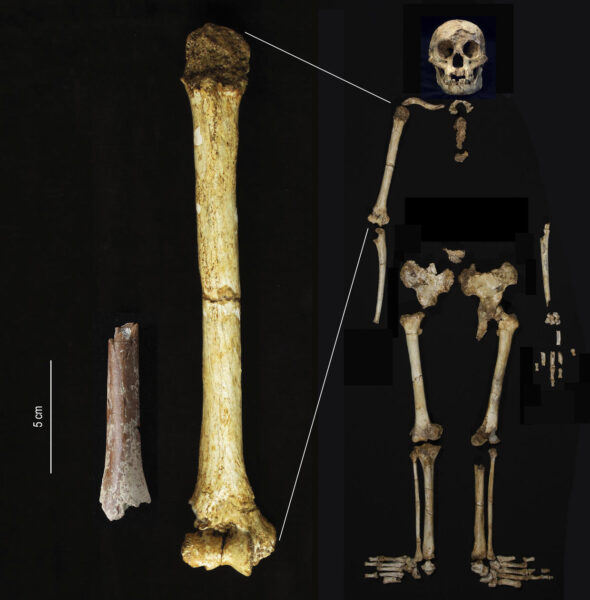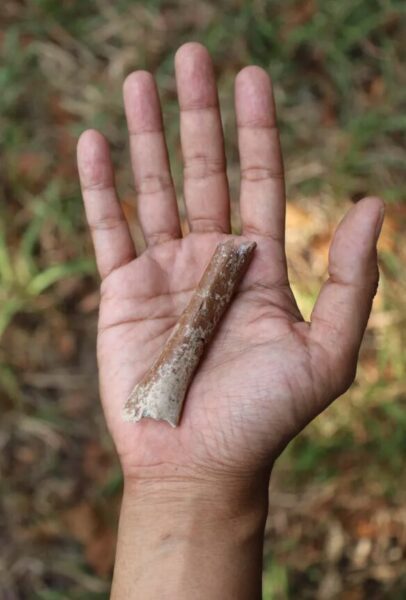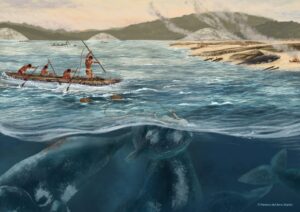One-meter-tall humans? It sounds incredible, something out of a Tolkien fantasy. But two decades ago, scientists discovered an ancient species of tiny humans. The hobbit-sized hominins lived on the Indonesian island of Flores 700,000 to 60,000 years ago. Researchers always believed they were approximately 1.07 meters tall. A newly found bone suggests they may have been even smaller.

Hobbit-sized humans: big hairy feet, elf ears, and a liking for brew not included. Illustration: Lucie Schrimpf/Wikimedia Commons
The new study focuses on a tiny arm bone and some teeth found at the Mata Menge site in 2016. This lies 72km away from the cave where the original remains turned up. The arm bone is 88mm long, and the incredibly small teeth indicate a smaller jaw.
These date back 700,000 years. This suggests that the hobbits lived on the island of Flores for hundreds of thousands of years and that the earlier ancestor hobbits were even smaller than their successors.
Researchers originally thought the fragment of arm bone belonged to a child because of its size, but microscopic analysis proves it belonged to an adult. Using the size of the arm bone and teeth, as well as a few other fossils from the site, the team estimates the older hobbits were just one meter tall.

The Mata Menge arm fragment, left, is slightly smaller than that of the original Homo floresiensis remains at Liang Bua. Photo: Yousuke Kaifu
The original Homo floresiensis fossils — named after the island of Flores where they lived — date to between 60,000 and 100,000 years. At the time, scientists nicknamed them “hobbits” due to their small stature. Why they are so small and where they fall in human evolution is a mystery. They may have been one of the last species of early humans to go extinct.
The initial discovery 20 years ago led to several theories. Some believed they were a separate species, others that they evolved from an unknown but similarly sized predecessor. Another theory suggested they were a tribe of modern humans with stunted growth.
The most widely accepted idea is that they evolved from Homo erectus, a taller ancient human species. The new study strengthens this theory. Though larger, the Homo erectus remains from nearby Java share many similarities with the Homo floresiensis fossils.
The Homo erectus fossils on Java are between 800,000 and 1.1 million years old. If this is how they evolved, “this means that Homo floresiensis experienced dramatic body size reduction from large-bodied Homo erectus,” said Yousuke Kailua, lead author of the new study. Homo erectus were about as tall as modern humans.

The arm bone fragment found in 2016. Photo: Yousuke Kaifu
The little humans would have shared the island with many unusually sized species. Pygmy elephants, giant rats, and Komodo dragons would all have been present at the time they existed. Komodo dragons would have loomed as large as dinosaurs to the hobbits.
No sign of these diminutive humans has turned up anywhere else, so it seems they adapted specifically to life on Flores.
“It is thought that the main reason for this size reduction over many generations is that being small has more advantages than being large on an island,” said co-author Gerrit van den Bergh. “Periodic shortages of food are most likely the main selective force toward smaller body size.”
The trend of ancient small island species is not new. Known as island dwarfism, it has appeared across the Mediterranean and Indonesia, yielding what are essentially mini-versions of ancient mainland megafauna.
“[With animals], no one has a problem with island dwarfism, but when it comes to hominins, it seems somehow more difficult to accept,” Bergh told The Guardian.
Why the hobbits are no longer with us is less of a mystery. The new discovery makes it clear that they survived on the island for a considerable time. They disappeared shortly after the emergence of Homo sapiens in the area. This “hardly seems a coincidence,” says co-author Adam Brumm.






